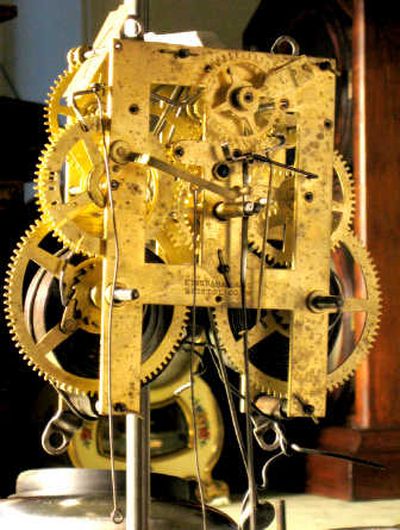New life for old clocks

RATHDRUM – For most people, peering into the intricate interiors of yesterday’s wind-up clocks is as mystifying as looking under the hood of their car or poking into the guts of a computer. For Randy Hirst of Rathdrum, they’re just beautiful puzzles.
Hirst spends his evening hours disassembling pieces of history, slowly restoring their utility and voice. He’s created a part-time business bringing old timepieces back to life for area clients.
“I get a certain satisfaction in taking something that hasn’t worked in 30 years and putting it back together,” Hirst said. “It’s also fascinating looking at something that they built 200 years ago. Some of that stuff is really pretty intricate for that era.”
As an example, Hirst described a German-made clock he worked on with several different functions all tied together in layers of gears.
“It’s a combination Westminster, chime, bing-bang and an hourly chime,” Hirst said. “I’ve probably got 16 hours just staring at it – and about two minutes fixing it.”
Hirst, a North Idaho native who works as the project manager for the Sandpoint Byway, began collecting old clocks more than a decade ago as a hobby. He said his interest in clocks grew out of childhood memories of his grandfather’s sprawling mansion in Spokane.
“He had four or five (grandfather clocks) in there and they just fascinated me,” he said.
Antique stores and specialty shops served as his primary source for many years. Then, he began attending clock conventions and digging through eBay auctions. Hirst estimates that he owns more than 60 clocks in various states of repair with five or six operational at any given time.
His repair business began a year ago as a natural extension of collecting. Many of the pieces he would find did not work, and he learned to repair them by reading books, researching online and studying the internal mechanisms. Now he repairs about two clocks a week. He said that most stopped clocks just need a thorough cleaning, but many more require a replacement gear, coil or spring.
“Parts are the biggest hang-up. Getting the part that you need is the hardest part,” Hirst said, adding that he often must build a part from scratch.
Almost every job involves pulling the clock apart, according to Hirst. A repair usually takes about three weeks to complete. Because of the time involved, Hirst examines the piece first and provides an estimate for the owner. Sometimes Hirst receives clocks that aren’t worth his time to repair.
“The big problem is they have an heirloom and it’s a nice clock, and then you find out it’s made in Korea,” he said.
Still, Hirst is willing to tackle anything that winds up, except pocket watches.
“If it’s got a pendulum, I can fix it,” Hirst said. “If it has a balance spring, I usually can get them running, but they often lose time.”